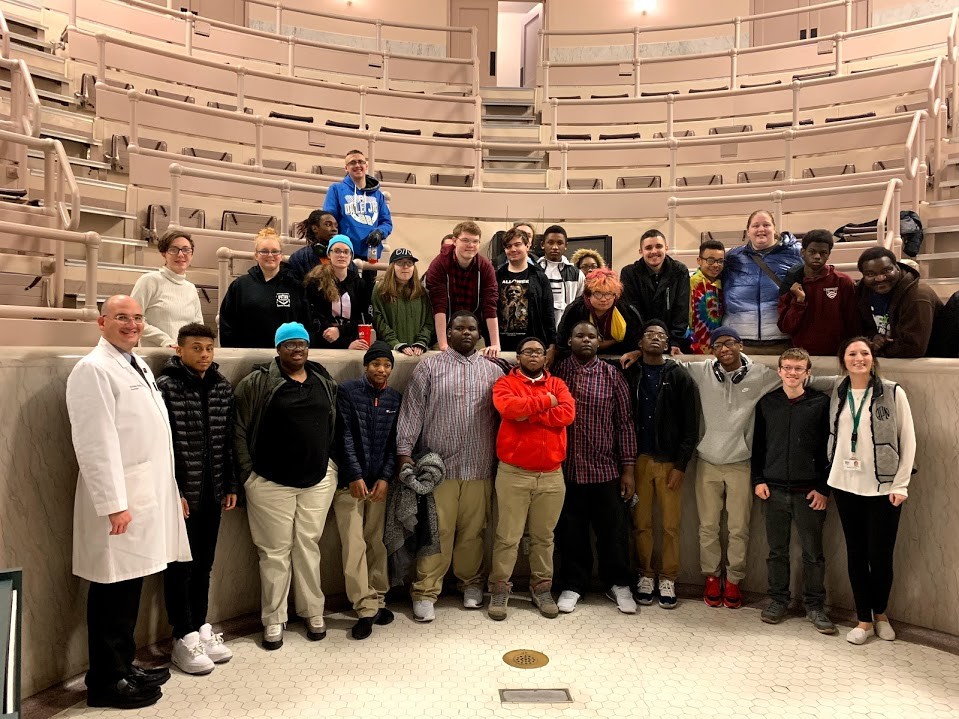
UC Brain Tumor Center offers high school students a peek inside the brain
High school students from Summit Academy visit campus to learn about brain tumors and neurosurgery.
In the memoir "Death Be Not Proud," first published in 1949, a father recounts the story of his son, Johnny Gunther, who was only 17 years old when he died of a brain tumor. The book details what his son bravely endured, sharing what a brave and spirited boy Johnny was, while also providing hope and comfort to those in similar experiences.
Though decades old, the story continues to be a powerful one, and was recently read by juniors and seniors at Summit Academy Transition High in Cincinnati. Their English teacher, Rebecca Plaatje, saw an opportunity to take the lesson outside the classroom and asked experts at the University of Cincinnati (UC) Brain Tumor Center for a peek into the world of caring for patients with brain tumors.
“I introduced them to what a brain tumor looks like and had examples, but I thought they would benefit most by hearing from a specialist in this field,” says Plaatje.
Summit Academy is a high school for alternative learners. Students may have learning difficulties, diagnosed developmental delays or transitional living situations—any variety of circumstances where the students “may need some additional support to reach specified goals,” says Plaatje.

Nicholas Marko, MD, associate professor and director of the UC Brain Tumor Center, shown here in the UC Medical Center surgical amphitheater, presents a slide of a brain with a tumor.
Working with Cathy Chien at the UC Gardner Neuroscience Institute, Plaatje arranged for the students to tour the UC campus followed by a meeting with Nicholas Marko, MD, director of the UC Brain Tumor Center and a UC Health neurosurgeon.
That afternoon, 30 students filed into the surgical amphitheater at the UC Medical Center, a historic space more than 100 years old that was originally modeled to allow new surgeons to observe surgical procedures. Marko spoke to them primarily about glioblastoma, the type of brain tumor that Gunther has in the memoir.
“Gliboblastoma is the most common type of malignant brain tumor, but there are more than 130 types of possible brain tumors,” said Marko, who is also an associate professor in the Department of Neurosurgery at the UC College of Medicine. “A tumor is defined as cells growing in an uncontrolled fashion; glioblastoma is an especially destructive tumor growth. So if possible, we need to take it out.”
After an overview of brain tumor diagnosis, Marko shared images and an educational video of brain surgery to show students how he approached surgical removal of malignant brain tumors.
Some audible “ewws” and uncomfortable rustling could be heard through the amphitheater as the videos played, but then came a flurry of questions: “Does that clamp actually go into their brain?” “Does the patient feel pain?” “How much does it hurt?”
Marko answered that while the patient is under general anesthesia and cannot any feel pain, there are, on occasion, times when they need the patients awake so that surgeons can ensure they are not affecting parts of the brain that control speech or movement.
“And, the brain actually doesn’t feel pain the way other parts of our bodies do when they get hurt,” he said.
“How fast does it heal?” another student asked. Marko explained that while the incisions may heal in a couple weeks, the brain itself heals very slowly, taking months to a year to see full improvements.
He concluded by saying that while glioblastoma is very rare—1 in 50,000 people—today, doctors can extend the life expectancies with someone with glioblastoma by up to two years; when without treatment, life expectancy can be as short as 3 months. “We also manage the health and care of all of the patient, not just their brain/head … we want them to have control over their situation and feel like they are being treated like a family member.”
Several students came up to thank Marko personally after the talk and Plaatje said that she had “never seen her students so engaged.”
Featured image of Nicholas Marko, MD (far left), Rebecca Plaatje (far right), and students from Summit Academy. photo/ Alison Sampson
Related Stories
A partnership to end pancreatic cancer
December 19, 2025
Since 2010, BSI Engineering has raised more than $1.2 million for pancreatic cancer research at the University of Cincinnati Cancer Center in honor of a friend and inspiration to BSI’s founders, Bryan Speicher.
Broad co-opportunities
December 18, 2025
Sakura Adachi exemplifies the Bearcat spirit: she works hard, she gives back and she takes full advantage of the opportunities the University of Cincinnati offers.
UC medical students explore ChatGPT’s ability to support qualitative research
December 18, 2025
Newly published research in the journal Medical Science Educator highlights University of Cincinnati College of Medicine student-led work in medical education and examines how artificial intelligence can assist with qualitative research.
